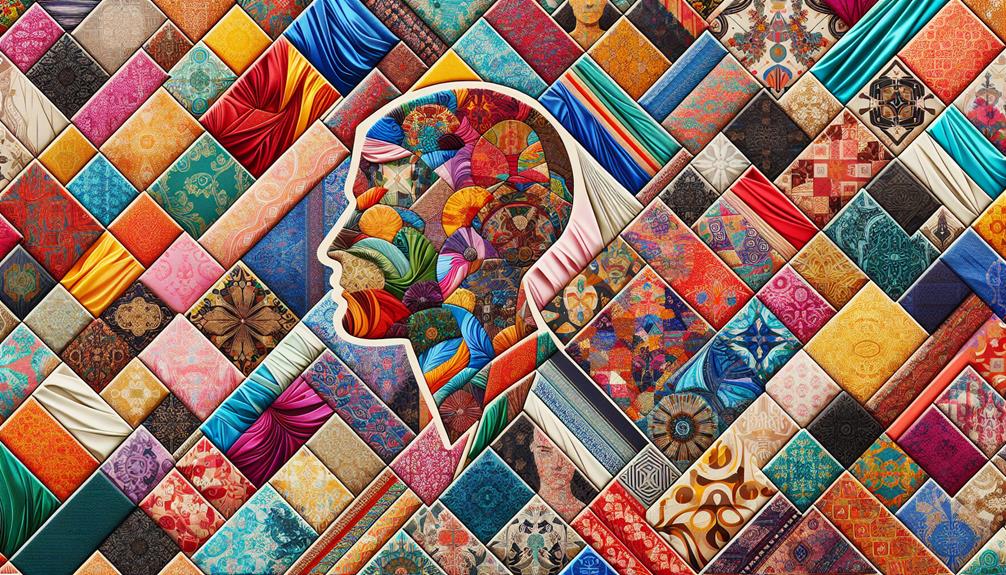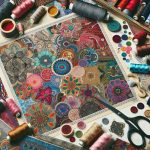Imagine walking through a room adorned with William Morris's intricate patterns or wearing a scarf designed by Vera Neumann; these experiences highlight the enduring impact of legendary fabric designers. You might wonder how these artists transformed the textile industry and inspired future generations. Each designer, from Liberty of London to Kaffe Fassett, brought unique innovation and creativity to fabric design, shaping the aesthetics we admire today. Interested in discovering the stories behind these trailblazers and their contributions to the world of fashion and interior design? Their legacies offer a fascinating journey through the evolution of textile art.
Table of Contents
Key Takeaways
- William Morris revolutionized textile design with intricate, nature-inspired patterns and a philosophy of hand-crafted quality over mass production.
- Vera Neumann democratized design, transforming everyday items into art with vibrant and sophisticated aesthetics.
- Liberty of London blends tradition with innovation, creating globally recognized, high-quality fabrics with intricate patterns.
- Marimekko's bold patterns and vibrant colors have a lasting impact on modern fabric design in both home decor and fashion.
- Emilio Pucci introduced kaleidoscopic prints, making bold, wearable art that embodies freedom and joy.
William Morris
When you think of influential fabric designers, William Morris's name unquestionably stands out as a pioneer in the Arts and Crafts Movement. His work set off a textile revolution that still resonates today.
Morris didn't just create beautiful designs; he fundamentally changed how people viewed and produced textiles. His philosophy was rooted in the belief that art should be both functional and beautiful, a core tenet of the Arts and Crafts Movement.
To master the essence of Morris's impact, you'll want to understand his dedication to craftsmanship. He rejected mass production in favor of hand-crafted quality, which was revolutionary at a time when industrialization was taking over.
His intricate patterns, inspired by nature, were meticulously detailed and reflected a deep appreciation for the natural world. You can't overlook his use of bold colors and complex motifs, which became hallmarks of his style.
Vera Neumann
While William Morris revolutionized textile design in the 19th century, Vera Neumann brought vibrant, modern aesthetics to mid-20th century fabrics. As you explore her work, you'll notice how she infused everyday items with a sense of joy and sophistication through her use of bold colors and floral motifs.
Vera's designs weren't just for the elite; she made art accessible to everyone, democratizing design in a way that was both innovative and inspiring.
You can see her influence in the way she transformed simple household items into pieces of art. Her iconic scarves, for example, became a canvas for her creativity, showcasing her trademark vibrant hues and intricate floral patterns. Vera's approach was always about breaking boundaries and pushing the envelope, making her a true pioneer in textile design.
Her legacy lives on through the timeless appeal of her creations. By studying her work, you'll gain a deeper understanding of how to blend artistic expression with practical application. Vera Neumann's work is a masterclass in balancing boldness with elegance, teaching you that great design is as much about feeling as it's about function.
Liberty of London
Stepping into the world of Liberty of London, you immediately encounter an extraordinary fusion of tradition and innovation in textile design. Known for their intricate patterns and lush fabrics, Liberty of London's work is a testament to their profound historical impact and relentless textile creativity. You'll find that their designs often draw from a rich archive that spans over a century, while simultaneously pushing the boundaries of contemporary aesthetics.
The iconic Liberty prints are a seamless blend of the classic and the cutting-edge. Their unique approach to fabric design has garnered a global following among those who appreciate the fine balance of heritage and modernity.
| Feature | Description | Impact |
|---|---|---|
| Heritage | Designs inspired by archives over a century old | Maintains a timeless connection to textile history |
| Innovation | Cutting-edge techniques and contemporary styles | Keeps the brand relevant and ahead of trends |
| Iconic Prints | Signature patterns recognized worldwide | Establishes a strong, identifiable brand image |
| Quality | High-grade materials and craftsmanship | Ensures durability and customer loyalty |
| Global Influence | International presence and collaborations | Expands reach and cultural impact |
Marimekko
When you think of Marimekko, you can't ignore its bold, iconic patterns and vibrant colors that have captivated design enthusiasts worldwide.
Their influence extends far beyond Finland, reaching a global audience and leaving a lasting impact on modern fabric design.
You'll find their distinctive style in everything from home decor to fashion, making Marimekko a true design powerhouse.
Iconic Patterns and Designs
Marimekko's bold and vibrant patterns have become synonymous with innovative fabric design. When you explore their iconic collections, you'll notice how they masterfully blend vintage inspiration with modern reinterpretation. Each pattern tells a story, drawing from a rich tapestry of cultural symbols and artistic expression.
The famous Unikko poppy print, for instance, debuted in 1964 and has since become an emblem of Marimekko's fearless approach to design. You can see how Marimekko designers don't shy away from using vivid colors and striking shapes. Their patterns often evoke a sense of nostalgia while feeling thoroughly contemporary. This balance between old and new is what sets Marimekko apart. They take elements from the past but infuse them with a fresh, modern twist. It's this fusion that keeps their designs timeless yet always in vogue.
Marimekko's ability to capture the essence of different cultures through their prints also stands out. Whether it's Scandinavian minimalism or bold Eastern European motifs, they translate these influences into fabric art that speaks universally. By doing so, Marimekko not only honors traditional artistic expressions but also pushes the boundaries of modern design.
Global Influence and Reach
Across continents and cultures, Marimekko's influence has transformed global fashion and home décor with its distinctive patterns and vibrant designs. You can't escape the cultural impact Marimekko has had since its inception in 1951. The brand's bold, colorful prints have garnered international recognition, making it a beloved name from Helsinki to New York.
You're likely familiar with Marimekko's Unikko (poppy) pattern, a symbol of design evolution and contemporary relevance. This iconic print, introduced in the 1960s, remains fresh and influential, demonstrating how Marimekko adapts to modern trends while honoring its rich heritage. Their ability to evolve yet retain their unique identity is key to their enduring success.
Marimekko's global influence extends beyond fashion into home décor, where their textiles and housewares have become staples for those who appreciate design. The brand collaborates with international designers and retailers, ensuring their reach continues to expand. By embracing new technologies and sustainable practices, Marimekko stays at the forefront of the design world.
In mastering the art of combining tradition with innovation, Marimekko has cemented its place as a global design powerhouse. Their story is a proof of the lasting power of creativity and vision.
Zandra Rhodes
Zandra Rhodes, with her vibrant patterns and bold colors, revolutionized the world of fabric design. You'll find her work instantly recognizable by its daring, avant-garde designs and the intricate patterns that seem to tell a story. Rhodes doesn't just create fabrics; she breathes life into textile artistry. Her innovative techniques, such as using silk-screening to achieve unparalleled depth and texture, set her apart from her peers.
Rhodes' fashion collaborations further cement her status as a pioneer. When working with top fashion houses, she seamlessly integrates her signature bold colors and complex designs into their collections, enriching them with an unmistakable flair. You can see her influence in everything from haute couture to ready-to-wear lines, making her a versatile and sought-after designer.
Her work transcends mere fabric; it's a canvas for expression. Rhodes' designs often challenge the status quo, inviting you to see fabric as a form of high art. For those who desire mastery in the world of textile design, studying Rhodes' career offers invaluable insights into how innovative techniques and fearless creativity can redefine an industry. Her legacy is a reflection of the power of bold, visionary artistry.
Emilio Pucci
Emilio Pucci, often hailed as the 'Prince of Prints,' brought a burst of vibrant, kaleidoscopic patterns to the world of fabric design. His bold prints revolutionized the fashion landscape, making luxury fashion synonymous with vivid colors and dynamic shapes. When you think of Pucci, imagine a canvas exploding with geometric designs and psychedelic swirls, each piece more enchanting than the last.
You can't discuss Pucci without acknowledging his influence on the 1960s fashion scene. He didn't just create clothes; he crafted wearable art that defied conventional norms. His use of silk jersey and other luxurious fabrics further elevated his designs, making them must-haves for the fashion-forward elite.
Pucci's legacy isn't just about eye-catching aesthetics; it's about the freedom and joy his designs embody. Each pattern tells a story, a narrative of elegance and exuberance. When you wear Pucci, you're not just wearing a piece of fabric; you're draping yourself in a history of innovation and opulence.
In the domain of luxury fashion, Pucci's name is etched in gold. His bold prints continue to inspire designers and fascinate fashion aficionados, ensuring his place in the pantheon of legendary fabric designers.
Iris Apfel
Known for her eclectic style and larger-than-life personality, Iris Apfel has become an icon in the world of fashion and fabric design. She's not just a fashion icon; she's a living testament to the power of individuality. When you think of Apfel, you envision her bold, oversized glasses and her fearless approach to mixing patterns and colors. Her influence extends beyond clothing, impacting the domains of interior design as well.
Apfel's journey began with her company, Old World Weavers, which she co-founded with her husband in 1950. Through it, she revived and preserved rare fabrics, bringing them into modern interiors and fashion. You can't overlook her role in transforming the White House décor for nine different presidents. Her work there exemplifies her mastery in making spaces feel both opulent and inviting.
Moreover, her personal style has been celebrated in numerous exhibitions and collaborations, solidifying her status as a fashion icon. Her mantra, 'More is more, and less is a bore,' challenges you to embrace your uniqueness in both your wardrobe and your living spaces.
Apfel's legacy is a masterclass in blending fashion with interior design, encouraging you to see beauty everywhere.
Kaffe Fassett
How does one capture the vibrant essence of Kaffe Fassett's groundbreaking work in the world of fabric design? To truly grasp his impact, you must first immerse yourself in his colorful creations.
Fassett's designs are a kaleidoscope of bold patterns and vivid hues that defy the ordinary. His work isn't just about fabric; it's about transforming textiles into art. When you look at his pieces, you don't just see colors—you feel them.
Fassett's textile inspirations often draw from nature, art, and his travels. His ability to blend these elements into cohesive designs showcases his masterful eye for detail. Whether he's creating intricate floral motifs or geometric patterns, each design is a tribute to his unparalleled creativity.
To emulate Fassett's approach, you need to embrace a fearless use of color and pattern. He challenges you to think beyond traditional boundaries and explore new domains of design. His legacy isn't just in the fabrics he creates but in the inspiration he imparts to designers worldwide.
Frequently Asked Questions
What Are the Key Characteristics of Art Deco Fabric Design?
Did you know 80% of art deco designs feature geometric motifs? You'll find bold colors, symmetrical patterns, and lavish ornamentation. Immerse yourself in this era's fabric designs to appreciate the mastery of form and vibrant aesthetics.
How Has Digital Technology Impacted Modern Fabric Design?
Digital technology's transformed modern fabric design through textile innovation and sustainability. You've got virtual design tools enabling seamless collaboration, reducing waste, and promoting eco-friendly practices, ensuring a more efficient and creative process for designers.
What Is the Influence of Global Cultures on Contemporary Fabric Patterns?
It's ironic how traditional techniques shape contemporary fabric patterns more than modern influences. You'd think global cultures would favor new methods, but they blend ancient artistry with today's trends, creating a stunningly intricate tapestry.
How Do Fabric Designers Source Sustainable Materials?
You source sustainable materials by prioritizing eco-friendly sourcing and ethical practices. You focus on renewable resources and adopt an eco-conscious design philosophy, ensuring your fabric choices are both environmentally responsible and innovative.
What Role Do Fashion Trends Play in Fabric Design?
Fashion trends greatly shape fabric design. Did you know 70% of textile production is influenced by cultural influences and the fashion industry? Understanding historical context helps you anticipate trends and innovate within the constantly evolving fashion landscape.
- How to Source Curtain Fabric Directly From China - June 20, 2025
- The Appeal of Cotton Spandex Fabric From Chinese Suppliers - June 20, 2025
- Blue and White China: From Porcelain to Print Fabric - June 20, 2025







